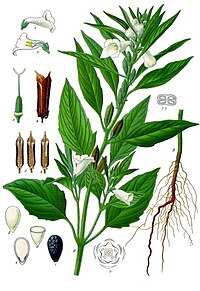
Photo from wikipedia
The present study was conducted to clarify the differences in the multi-element, volatile organic compound, fatty acid, and metabolite fingerprints between black and white sesame seeds. A total of 53… Click to show full abstract
The present study was conducted to clarify the differences in the multi-element, volatile organic compound, fatty acid, and metabolite fingerprints between black and white sesame seeds. A total of 53 chemical elements, 32 volatile flavor compounds, 40 fatty acids, and 283 metabolites were identified and evaluated in the two groups of sesame seeds. Univariate and multivariate statistics indicated a distinct separation between the two groups of sesame seeds. A panel of 16 chemical elements, 3 volatile compounds, 8 individual fatty acids, and 54 metabolites with p value < 0.05 and variable importance in projection score > 1 were selected as the most important discriminants for the two types of sesame seeds. Overall, these data reveal the influence of genotype on the chemical composition of sesame seeds. Our findings also demonstrate that the hybrid model of instrumental analysis and chemometrics is feasible for the discrimination of black and white sesame seeds.
Journal Title: Foods
Year Published: 2022
Link to full text (if available)
Share on Social Media: Sign Up to like & get
recommendations!